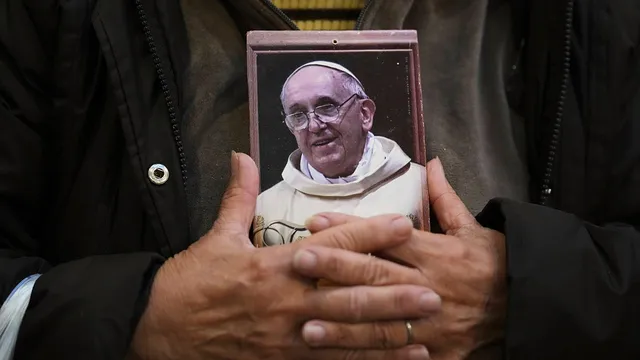
Pope Francis is laid to rest in Santa Maria Maggiore, defying centuries of tradition
2025-04-27 16:30- Pope Francis' funeral Mass occurred on April 26, 2025, attracting thousands of mourners.
- The ceremony was marked by simplicity and the presence of marginalized individuals to reflect the pope’s commitment to the poor.
- Pope Francis was buried at Santa Maria Maggiore, marking a significant change in papal burial tradition.
Express your sentiment!
Insights
On April 26, 2025, Pope Francis' funeral Mass took place on the steps of St. Peter's Basilica in Vatican City. This significant event drew thousands from all over Rome who lined the streets to pay their final respects to the late pope, celebrated for his advocacy for the poor and migrants, as well as his efforts to modernize the Catholic Church. The ceremony saw attendance from over 50 world leaders and 11 reigning monarchs, highlighting the global impact of his papacy. In line with Pope Francis’ desire for simplicity, the funeral proceedings focused on humble elements rather than opulence, reflecting his commitment to the disadvantaged. Many mourners reported a sense of peace during the ceremonies, which included multi-lingual readings and the participation of those less fortunate, embodying his inclusive approach. Specifically, a group of poor individuals was allowed on the steps of the basilica for one last goodbye, honoring the pope’s belief in serving the marginalized. Following the conclusion of the Mass, Pope Francis' modest wooden coffin was transported through Rome for public viewing before his burial, which took place at the Basilica di Santa Maria Maggiore, away from the public eye. His resting place will be made of Ligurian marble, an homage to his family heritage. This burial marks a unique moment in history, as it is the first time in over three centuries that a pope has been interred at this location, signifying a departure from traditional practices that would often involve more elaborate rituals and multiple coffins. The pope's loss will be felt widely, especially among Catholics, many of whom followed his progressive reforms and compassionate messages throughout his 12-year leadership. However, his tenure was not without challenges and criticisms, particularly concerning ongoing issues within the Church, such as handling clerical sexual abuse cases and debates over social issues. Pope Francis consistently aimed to bridge gaps within the Catholic community and promote a more open dialogue, which some followers believe allowed the Church to become more approachable and relevant to contemporary issues. As he is laid to rest, the legacies of his outreach work and advocacy for the neglected and oppressed will linger, as his papacy represented significant change in a centuries-old institution.
Contexts
The history of papal burial traditions is deeply intertwined with the evolution of the Roman Catholic Church and its governance over the centuries. In the early Christian period, popes were often buried in catacombs or other Christian burial sites, away from the persecution they faced. The first documented burial of a pope is that of Saint Peter, who is traditionally believed to be buried beneath St. Peter's Basilica in Vatican City. This practice established a precedence for the burial of popes at significant locations, emphasizing the sacredness of their final resting place and their connection to the apostolic lineage of the Church. As the Church grew in power and influence, burial practices evolved significantly. By the 9th century, it became common to bury popes in or near basilicas, and notable popes were interred with lavish ceremonies that included the construction of elaborate tombs. The Renaissance period marked a pinnacle in papal burial grandeur, with many popes commissioning artistically significant monuments celebrating their legacies. The most iconic of these is the tomb of Pope Julius II, designed by the renowned sculptor Michelangelo, which reflected the artistic and cultural aspirations of the time. The shift towards monumental burials was also influenced by the Church's desire to affirm its authority and sanctity. The use of opulent sarcophagi and tombs served as a visual manifestation of the pope's divine role as God's representative on Earth. Furthermore, the practice of embedding remains within the walls or floors of significant basilicas indicated a belief in the papal office's spiritual continuity. This practice has also reflected theological beliefs in the resurrection and the sanctity of the body, as the deceased popes were often venerated as saints, promoting further pilgrimage to their resting places. In the contemporary era, burial customs for popes have become more standardized, with most recent popes being interred beneath St. Peter's Basilica, reflecting both tradition and the evolving sentiments of the Church. Burial rituals today continue to honor the legacy and contributions of the deceased pope while adapting to modern practices. The historical evolution of these traditions indicates an ongoing connection between the Church's past and its current identity, symbolizing the enduring significance of papal leadership and the religious and cultural history of the Roman Catholic community.